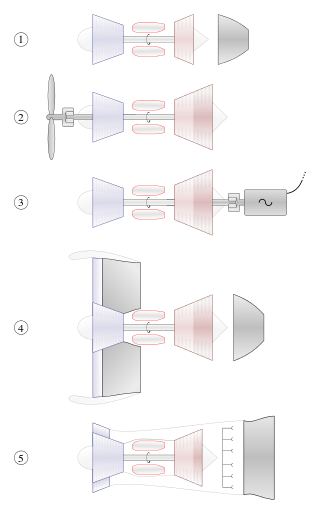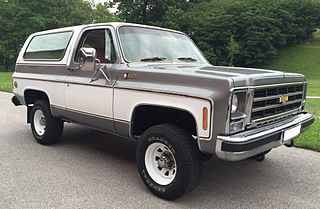Related Research Articles

In an internal combustion engine, a turbocharger is a forced induction device that is powered by the flow of exhaust gases. It uses this energy to compress the intake air, forcing more air into the engine in order to produce more power for a given displacement.

A gas turbine, also called a combustion turbine, is a type of continuous flow internal combustion engine. The main parts common to all gas turbine engines form the power-producing part and are, in the direction of flow:

The Chevrolet Corvair is a compact car manufactured by Chevrolet for model years 1960–1969 in two generations. A response to the Volkswagen Beetle, it remains the only American-designed, mass-produced passenger car with a rear-mounted, air-cooled engine. The Corvair was manufactured and marketed in 4-door sedan, 2-door coupe, convertible, 4-door station wagon, passenger van, commercial van, and pickup truck body styles in its first generation (1960–1964) and as a 2-door coupe, convertible or 4-door hardtop in its second (1965–1969) – with a total production of approximately 1.8 million from 1960 until 1969.

Pony car is an American car classification for affordable, compact, highly styled coupés or convertibles with a "sporty" or performance-oriented image. Common characteristics include rear-wheel drive, a long hood, a short decklid, a wide range of options to individualize each car and use of mass-produced parts shared with other models.

The Chevrolet Turbo-Air 6 is a flat-six air-cooled automobile engine developed by General Motors (GM) in the late 1950s for use in the rear-engined Chevrolet Corvair of the 1960s. It was used in the entire Corvair line, as well as a wide variety of other applications.

Hydramatic is an automatic transmission developed by both General Motors' Cadillac and Oldsmobile divisions. Introduced in 1939 for the 1940 model year vehicles, the Hydramatic was the first mass-produced fully-automatic transmission developed for passenger automobile use.

The Chevrolet K5 Blazer is a full-size sport-utility vehicle that was built by General Motors. GM's smallest full-size SUV, it is part of the Chevrolet C/K truck family. Introduced to the Chevrolet line for the 1969 model year, the K5 Blazer was replaced for 1995 by the Chevrolet Tahoe. The third generation was simply called "Chevrolet Blazer", without the K5 name. In 1970, GMC introduced its own model of the truck, called the Jimmy, which was discontinued in 1991 and replaced by the Yukon. The "Jimmy" name was chosen to reflect how GM may sound in a similar manner to how Jeep was thought to be a pronunciation of GP in the competing market. Both were short-wheelbase trucks and available with either rear- or four-wheel drive.
Turbo-Hydramatic or Turbo Hydra-Matic is the registered tradename for a family of automatic transmissions developed and produced by General Motors. These transmissions mate a three-element turbine torque converter to a Simpson planetary geartrain, providing three forward speeds plus reverse.

Specialty Equipment Market Association (SEMA) of the automobile aftermarket was formed in 1963 by Roy Richter, Ed Iskenderian, Els Lohn, Willie Garner, Bob Hedman, Robert E. Wyman, John Bartlett, Phil Weiand Jr, Al Segal, Dean Moon, and Vic Edelbrock Jr. and now consists of 6,383 companies worldwide, bringing together aftermarket manufacturers, original equipment manufacturers (OEM), media, car dealers, specialty equipment distributors, installers, retailers, and restoration specialists.

A gas turbine locomotive is a type of railway locomotive in which the prime mover is a gas turbine. Several types of gas turbine locomotive have been developed, differing mainly in the means by which mechanical power is conveyed to the driving wheels (drivers). A gas turbine train typically consists of two power cars, and one or more intermediate passenger cars.
The Pontiac Banshee is a line of concept cars designed by Pontiac, assuming the role previously established by General Motors' Firebirds of the 1950s. Four Banshee "dream cars" were fabricated through 1988 as design exercises intended to establish exterior and interior themes that could be modified for production versions of Pontiac sports and performance cars. Banshee was also the leading candidate for Pontiac's version of the Camaro before being named Firebird in light of any deathly associations of the word Banshee.
The name Chevrolet Greenbrier was used by Chevrolet for two vehicles. The first vehicles were a six-to-nine-passenger window van version of the Corvair 95 van. The Corvair 95 series also included the Loadside pickup truck and Rampside pickup truck that featured a mid-body ramp on the right side. All used the Corvair powertrain in a truck body and were produced in the model years 1961 to 1965.

The GM New Look bus is a municipal transit bus that was introduced in 1959 by the Truck and Coach Division of General Motors to replace the company's previous coach, retroactively known as the GM "old-look" transit bus.
The General Motors Firebird comprises a quartet of prototype cars that General Motors (GM) engineered for the 1953, 1956, and 1959 Motorama auto shows. The cars' designers, headed by Harley Earl, took Earl's inspiration from the innovations in fighter aircraft design at the time. General Motors never intended the cars for production, but rather to showcase the extremes in technology and design that the company was able to achieve.

The GMC Astro is a heavy-duty cabover truck that was manufactured by the GMC Truck and Coach Division of General Motors from the 1969 to 1987 model years. Succeeding the F/D-series "Crackerbox" cabovers, the Astro was marketed by Chevrolet as the Titan, serving as the largest cabover trucks ever produced by General Motors.

The GM "old-look" transit bus was a transit bus that was introduced in 1940 by Yellow Coach beginning with the production of the model TG-3201 bus. Yellow Coach was an early bus builder that was partially owned by General Motors (GM) before being purchased outright in 1943 and folded into the GM Truck Division to form the GM Truck & Coach Division. The Yellow Coach badge gave way to the GM nameplate in 1944. Production of most "old-look" models was stopped upon the release of the GM New-Look bus in 1959, however some smaller "old-look" models continued to be built until 1969. Approximately 38,000 "old-look" buses were built during the 29-year production run. The "old-look" name is an unofficial retronym applied to this series of GM buses after the release of the GM New-Look series.

The Rover-BRM was a prototype gas turbine-powered racing car, jointly developed in the early 1960s by the British companies Rover and British Racing Motors (BRM). The car is part of the collection at the British Motor Museum.

The Chevrolet Turbo-Thrift engine is a straight-six produced from 1962 to 2001 by the Chevrolet Division of General Motors. The entire series of engines was commonly called Turbo-Thrift, although the name was first used on the 230 cubic inch version that debuted in 1963. The new engine featured seven main bearings in lieu of the four bearing design of its predecessor, the "Stovebolt" engine, and was considerably smaller and approximately 100 lbs lighter.

The GMWhirlfire gas turbine engines were developed in the 1950s by the research division of General Motors Corporation and fitted to concept vehicles, including the Firebird concept cars, Turbo-Cruiser buses, and Turbo-Titan trucks through the 1960s. They are free-turbine turboshaft machines with two spools: one compressor/gasifier turboshaft and one power/output turboshaft sharing a common axis without a mechanical coupling between them. Fuel consumption of the first-generation GT-300 was high compared to piston engines, so thermal wheel regenerators were added to the second-generation GT-304, cutting consumption by approximately 1⁄2.
References
- 1 2 3 4 5 6 7 8 9 "Turbo-Titan III ... a glimpse into tomorrow's trucking!" (PDF). Chevrolet. 1965.
- ↑ Turunen, W.; Collman, J. (1965). "The General Motors Research GT-309 Gas Turbine Engine". SAE Transactions. 1: 357–377. doi:10.4271/650714. JSTOR 44554219.
- ↑ "Video: Big Red, Ford's 1964 Turbine Truck". Mac's Motor City Garage. February 11, 2016. Retrieved 8 February 2022.
- 1 2 Lyndall, Jack (November 1964). "The coming age of turbine power ... Can it meet the challenge of tomorrow's superhighways". Fleet Owner. Retrieved 8 February 2022.
- 1 2 3 4 "Seven: 1960-1969 | Marketing of Performance". General Motors: The first 75 years of transportation products . Automobile Quarterly. 1983. pp. 162–163. ISBN 0-915038-41-2.
- ↑ "Turbine Dream Truck: 1966 Chevrolet Turbo Titan III". Mac's Motor City Garage. February 16, 2019. Retrieved 8 February 2022.
- ↑ Niedermeyer, Paul (September 20, 2020). "Curbside Classic: 1960 – 1980 Chevrolet Tilt Cab Truck – Never As Popular As The Ford C-Series Thanks To A Near Deadly Sin". Curbside Classic. Retrieved 8 February 2022.
- 1 2 Senefsky, Bill (September 1, 2003). "Chevrolet Turbo-Titan III Concept Vehicle – Space Truckin'". Motor Trend. Retrieved 8 February 2022.
- ↑ Brophy, Jim (June 2, 2018). "Bus Stop Classics: General Motors (GM) Turbo Cruiser I, II and III Urban Transit Coaches — Maverick (Top Gun), Your Bus is Here ..." Curbside Classic. Retrieved 8 February 2022.